By MARK GREGORY
Machinery extrication, or “Man vs. Machine,” occurs all across the country. Whether you are a career or volunteer firefighter working in an urban or a rural area, the possibility of going to one of these incidents is ever present. The tools used to disentangle a victim are commonly carried on fire apparatus across the country. Is your department prepared to handle a “Man vs. Machine” emergency?
Scenario: Assigned as the officer on your department’s heavy rescue company, you are dispatched to an “unknown type trauma” at a local mill. Initial reports advise of a worker who has his arm stuck in a press-type machine. Units on scene confirm the incident and request an expedited response from your company. The victim is a 24-year-old male who has had both of his arms completely pulled through the rollers of a press machine.
Entering the facility, your crew has its basic complement of tools for this emergency. Through years of experience, your company has developed a “Man vs. Machine” kit, which is comprised of small wedges, sockets, lockout devices, and some tools that have been devised over the years. This kit will allow you to start your operation until you determine what additional tools you will need for the extrication. The rescue chauffeur remains at the vehicle to supply you with other logistical needs. You request one of the engine companies to assist with shuttling further tools. This will allow you to keep the remaining members of your company together to perform the operation.
As you approach the press machine, it is obvious that the worker has both arms completely pinned between two large rollers (photo 1). Lockout/tag-out has been successfully completed. The machine and its backup power supply have been completely deenergized (photo 2); keep in mind many large-scale machines will have backup power sources. Plant personnel can be extremely useful in extrication and should be treated as a valuable resource.
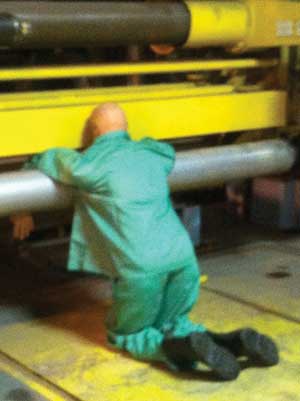 |
| (1) Photos by author. |
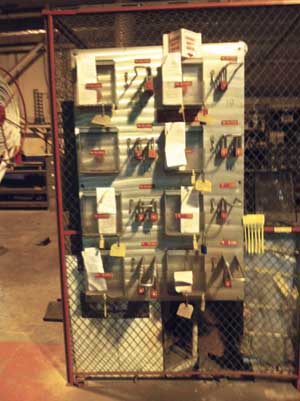 |
| (2) |
The medical personnel have assessed the patient and will treat him with advanced life support (ALS) procedures. The ball is now in your court to effectively extricate this individual.
Your crew needs to size up the complete situation. “Tunnel vision” can lead to further patient injury. I always remind my crew that “every action has a reaction.” In other words, think of what will happen once a specific technique is put into play. While deciding on the extrication plan, the crew decides that loosening the rollers will be the best course of action. The questions here are, What happens when the rollers are loosened? Will the weight of the rollers shift, causing additional problems? The roller may weigh several hundred pounds. Depending on the use of the machine, the roller may even be heated, which is a common feature in many paper mills. Make sure to check behind the rollers, as serrated blades may also be present (photo 3).
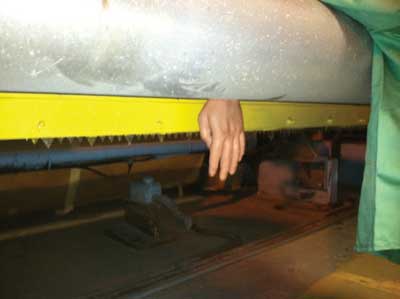 |
| (3) |
The crew decides to loosen the rollers to free the victim. The first attempt will involve loosening just the top roller. Loosening the bolts on one side may be enough to effect the extrication. A chain hoist is brought over from the rescue truck to secure the weight of the roller as it is loosened (photo 4). Members of your team locate a high point from which to anchor the chain hoist. The chain is hitched around the roller and secured to itself; nylon slings may also be an option if you are not dealing with a heated roller system. Tension is put on the roller slightly, and you give the “OK” for your crew to continue loosening the bolts holding the roller in place. Depending on the manufacturer, you can decipher whether standard or metric sockets must be used. Commonly, American-built and older machines use standard sockets. Universal sockets also work well, since one socket covers a multitude of sizes and takes the guesswork out of figuring the proper size. Maintenance personnel may even have the necessary socket on site.
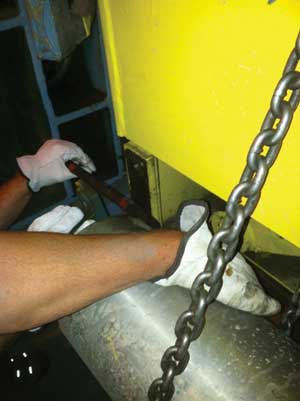 |
| (4) |
The bolts have been loosened, and the chain hoist is now supporting the roller’s load. A pinch bar or officer’s tool may be required to free the bolt to gain space (photo 5). How much room is needed? Just enough to free the victim. The roller is completely free on one side, and the victim’s arms can be removed from the machine. Your victim should now be fully immobilized on a backboard with collar.
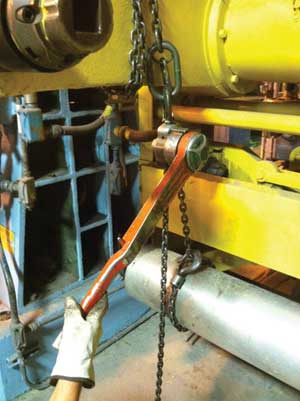 |
| (5) |
Medical personnel can continue their ALS measures by treating the victim with IV solution to counteract any of the effects of crush syndrome while preparing to transport him to the nearest trauma center.
Today, most responders carry a cell phone during their shift. Taking pictures of the extrication process can benefit your company’s other platoons by allowing them to drill on actual pictures of the methods used to perform the extrication. With photos, emergency medical service personnel can document to the emergency room physicians the type of entrapment device that caused the injury. However, all members distributing such photos must exercise caution and adhere to departmental policies regarding social media.
As first responders, we are the public’s “cure-all” for many situations ranging from broken water pipes to a person with his hand stuck in a snow blower. Thinking that “this type of stuff never happens in my district” demonstrates a poor attitude. Rescuers should train on various situations, what I like to call “10 Minute What-If Drills.”
On your next shift, drive by the local park and ask your crew, “What if a child were stuck in this swing? How would you remove him?” The proficiency of your crew is paramount to the survival of the public we are sworn to protect.
● MARK GREGORY is a 25-year fire service veteran and a lieutenant in the Fire Department of New York (FDNY) assigned to Tower Ladder 111 for the past nine years. He has previously worked as a firefighter with Rescue 2 and Ladder 132. Gregory instructs for the FDNY Academy as an Annual Education Day and extrication instructor. He also instructs at the Suffolk County (NY) Fire Academy and is the lead instructor for FDIC’s HOT Program “Man vs. Machinery,” taught by P.L. Vulcan Fire Training Concepts LLC.
Mark Gregory will present “Man vs. Machinery Incidents: Are You Prepared?” on Wednesday, April 24, 2013, 3:30 p.m.-5:15 p.m., at FDIC 2013 in Indianapolis.
Fire Engineering Archives

